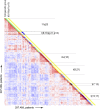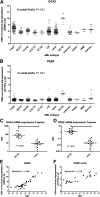Pediatric acute myeloid leukemia with t(8;16)(p11;p13), a distinct clinical and biological entity: a collaborative study by the International-Berlin-Frankfurt-Munster AML-study group
- PMID: 23974201
- PMCID: PMC4314534
- DOI: 10.1182/blood-2013-02-485524
Pediatric acute myeloid leukemia with t(8;16)(p11;p13), a distinct clinical and biological entity: a collaborative study by the International-Berlin-Frankfurt-Munster AML-study group
Abstract
In pediatric acute myeloid leukemia (AML), cytogenetic abnormalities are strong indicators of prognosis. Some recurrent cytogenetic abnormalities, such as t(8;16)(p11;p13), are so rare that collaborative studies are required to define their prognostic impact. We collected the clinical characteristics, morphology, and immunophenotypes of 62 pediatric AML patients with t(8;16)(p11;p13) from 18 countries participating in the International Berlin-Frankfurt-Münster (I-BFM) AML study group. We used the AML-BFM cohort diagnosed from 1995-2005 (n = 543) as a reference cohort. Median age of the pediatric t(8;16)(p11;p13) AML patients was significantly lower (1.2 years). The majority (97%) had M4-M5 French-American-British type, significantly different from the reference cohort. Erythrophagocytosis (70%), leukemia cutis (58%), and disseminated intravascular coagulation (39%) occurred frequently. Strikingly, spontaneous remissions occurred in 7 neonates with t(8;16)(p11;p13), of whom 3 remain in continuous remission. The 5-year overall survival of patients diagnosed after 1993 was 59%, similar to the reference cohort (P = .14). Gene expression profiles of t(8;16)(p11;p13) pediatric AML cases clustered close to, but distinct from, MLL-rearranged AML. Highly expressed genes included HOXA11, HOXA10, RET, PERP, and GGA2. In conclusion, pediatric t(8;16)(p11;p13) AML is a rare entity defined by a unique gene expression signature and distinct clinical features in whom spontaneous remissions occur in a subset of neonatal cases.
Figures




Comment in
-
Another piece of the AML puzzle.Blood. 2013 Oct 10;122(15):2532-4. doi: 10.1182/blood-2013-09-523662. Blood. 2013. PMID: 24113794 No abstract available.
References
-
- Haferlach T, Kohlmann A, Klein HU, et al. AML with translocation t(8;16)(p11;p13) demonstrates unique cytomorphological, cytogenetic, molecular and prognostic features. Leukemia. 2009;23(5):934–943. - PubMed
-
- Camós M, Esteve J, Jares P, et al. Gene expression profiling of acute myeloid leukemia with translocation t(8;16)(p11;p13) and MYST3-CREBBP rearrangement reveals a distinctive signature with a specific pattern of HOX gene expression. Cancer Res. 2006;66(14):6947–6954. - PubMed
-
- Gervais C, Murati A, Helias C, et al. Groupe Francophone de Cytogénétique Hématologique. Acute myeloid leukaemia with 8p11 (MYST3) rearrangement: an integrated cytologic, cytogenetic and molecular study by the groupe francophone de cytogénétique hématologique. Leukemia. 2008;22(8):1567–1575. - PubMed
Publication types
MeSH terms
Grants and funding
LinkOut - more resources
Full Text Sources
Other Literature Sources
Medical

